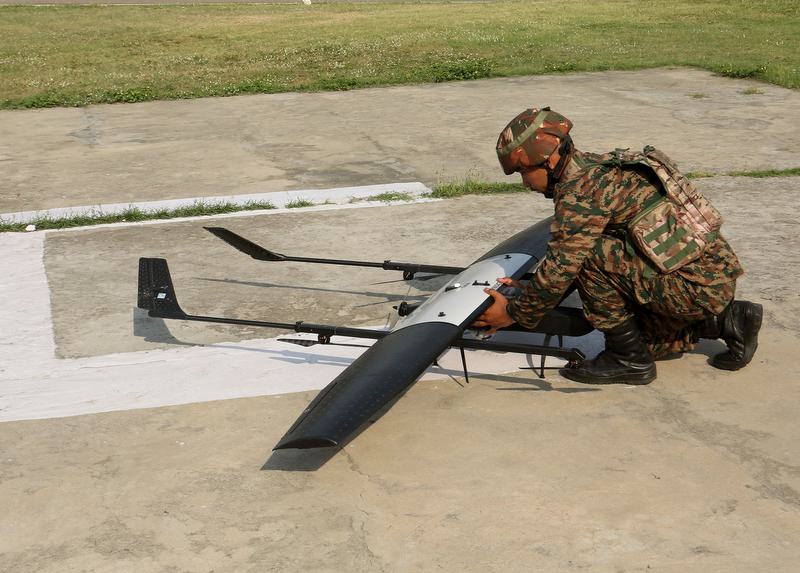"How drones are the new face of warfare"

×
![]()
Prelims - Key Facts and Developments
- Operation Sindoor: India’s active combat operation involving drones and standoff weapons post the Pahalgam terror attack.
- Nagorno-Karabakh War (2020): Azerbaijan used loitering munitions (kamikaze drones) like Israeli Harop, changing the dynamics of aerial warfare.
- Ukraine’s Operation Spider Web: Targeted Russian airbases using low-cost drones, highlighting strategic utility of improvised UAVs.
- Myanmar: Rebels using 3D-printed drones to counter conventional military advantage.
- Chinese Drones: Models like Wing Loong II, Soaring Dragon, BZK-005, CH-901 – pose a significant threat to India.
- India's Counter-UAV Systems: Include soft-kill (jamming) and hard-kill (kinetic weapons) measures.
- Integration under IACCS: India’s Integrated Air Command and Control System played a key role in recent engagements with Pakistan.
Technology & Innovation
- AI & Machine Vision: Used to bypass jamming and spoofing.
- Tethered Drones: Fibre-optic guided drones in Ukraine to avoid electronic countermeasures.
- 3D Printing: Adopted in Ukraine (Titan Falcon) and Myanmar (Liberator MK1 & MK2) to produce drone parts during war.
- Frequency Hopping and Swarm Tactics: Used to evade radar and overwhelm air defences.
Mains - Key Topics for Answer Writing
- 1. Evolution of Drone Warfare: Drones are now central to modern combat, transforming military doctrine globally. Used in active combat, surveillance, strategic strikes, and asymmetric warfare. Blurs the line between military-grade and commercial technology (e.g., off-the-shelf drones converted into weapons).
- 2. Indian Context & Strategic Shift: Operation Sindoor marked India’s entry into integrated drone warfare. Drones offer strategic ambiguity and non-nuclear offensive options against adversaries. China’s export of drones to Pakistan and its own UAV arsenal add to India’s dual-front threat.
- 3. Counter-Drone Measures: India uses layered counter-drone systems (IACCS, soft-kill and hard-kill tech). Effective in neutralizing Pakistani drone incursions. Need for further investment in anti-drone tech, especially for internal security and civilian infrastructure.
- 4. Lessons from Global Conflicts:
- Ukraine: Mass production + innovation with limited resources; machine vision, AI navigation, swarming, terrain mapping.
- Nagorno-Karabakh: Kamikaze drones proved decisive.
- Myanmar: 3D printing = democratization of drone warfare.
- 5. Challenges in India’s Defence Industrial Ecosystem: Low volume procurement deters industry investment in mass production. Urgent need to scale up indigenous drone production and develop surge capacity for replenishment during conflict. MoD support required to streamline procurement and build a robust defence manufacturing base.
- 6. Strategic Imperatives for India: View drones as asymmetric force multipliers, especially vs China. Ensure domestic production of loitering munitions, tactical UAVs. Develop affordable, modular, and redundant systems for scale and rapid deployment. Integrate internal security frameworks with military drone doctrines.
Conclusion (for Mains Answer Framing)
The modern battlefield is increasingly shaped by the use of drones — low-cost, agile, and strategic. India must learn from global precedents and invest in drone ecosystems, both for offence and defence. The synergy of innovation, domestic capacity, and policy support will determine India’s preparedness for drone-centric warfare in the coming decades.
Prelims MCQ
Q1. With reference to the recent global developments in drone warfare, consider the following statements:
- Kamikaze drones are used primarily for aerial surveillance and are retrieved after mission completion.
- The Nagorno-Karabakh conflict in 2020 demonstrated the use of drones to destroy enemy air defence systems.
- Ukraine has deployed fibre-optic tethered drones to bypass electronic warfare measures.
Which of the statements given above is/are correct?
- (a) 2 and 3 only
- (b) 1 and 2 only
- (c) 3 only
- (d) 1, 2 and 3
Answer: (a)
Statement 1 is incorrect: Kamikaze drones are loitering munitions—not surveillance drones—and they are not retrieved. Statements 2 and 3 are correct.
Q2. Consider the following statements regarding India’s Integrated Air Command and Control System (IACCS):
- IACCS enables integration of India's multi-layered air defence systems for real-time coordination.
- It was instrumental in intercepting Pakistani drones and missiles during the Operation Sindoor conflict.
- It includes both offensive drone strike capabilities and satellite-based surveillance.
Which of the above are correct?
- (a) 1 and 2 only
- (b) 2 and 3 only
- (c) 1 and 3 only
- (d) 1, 2 and 3
Answer: (a)
Statement 3 is incorrect: IACCS is primarily for defensive coordination, not an offensive strike system.
